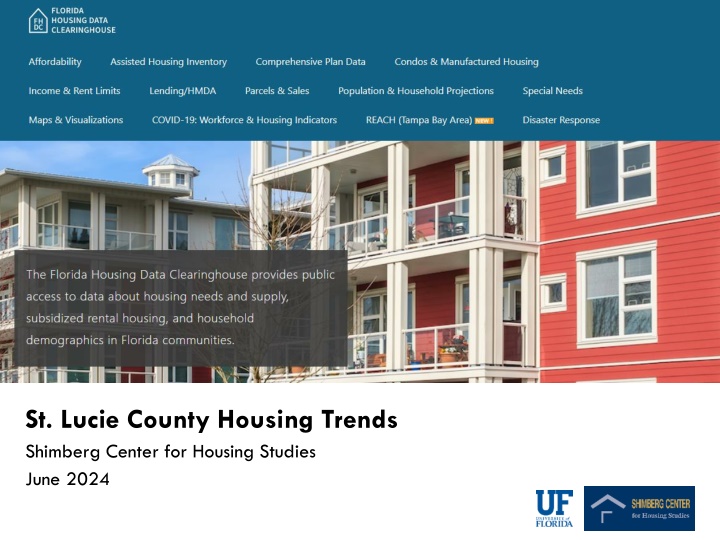
St. Lucie County Housing Trends 2024 Analysis
Explore the housing trends in St. Lucie County, Florida, focusing on the fluctuation of home prices, affordability metrics, and income levels. Discover how housing costs have evolved over the years, impacting the local community and workforce.
Download Presentation

Please find below an Image/Link to download the presentation.
The content on the website is provided AS IS for your information and personal use only. It may not be sold, licensed, or shared on other websites without obtaining consent from the author. If you encounter any issues during the download, it is possible that the publisher has removed the file from their server.
You are allowed to download the files provided on this website for personal or commercial use, subject to the condition that they are used lawfully. All files are the property of their respective owners.
The content on the website is provided AS IS for your information and personal use only. It may not be sold, licensed, or shared on other websites without obtaining consent from the author.
E N D
Presentation Transcript
St. Lucie County Housing Trends Shimberg Center for Housing Studies June 2024
St. Lucie County home prices fell steeply in the 2008-2012 housing bust. Prices have since returned to their peak levels. $450,000 Florida $400,000 St. Lucie County $350,000 The county median price fell steeply to $141,000 in 2012, then began rising. $300,000 $250,000 $200,000 The county median price now exceeds its mid-2000s peak and is approaching the statewide median again (median St. Lucie price $380,000 in Q1-2 2023, compared to $400,000 statewide). $150,000 St Lucie County's median home sale price very closely tracekd the state's during the mid-2000s housing boom, peaking at $375,000 in 2006 (2023 $). $100,000 $50,000 $0 2003 2005 2007 2009 2011 2013 2015 2017 2019 2021 2023 Q1-2 Median Single Family Home Sale Price, St. Lucie County & Florida, 2003-2023 (2023$) Source: Shimberg Center analysis of Florida Department of Revenue, Sales Data Files. All values in 2023 dollars to correct for inflation.
Affordable Housing Terminology Housing is usually considered to be affordable if it costs no more than 30% of household income. Cost burdened: Paying more than 30% of income for owner or renter costs Severely cost burdened: Paying more than 50% of income Area median income (AMI):Used to create standard income measures across places and household sizes, expressed as % AMI
Example: 2024 St. Lucie County Income (% AMI) and Housing Cost Limits Max. affordable monthly housing cost (1-3 bedroom unit) Annual income range (1-4 person household) Hourly wage, 1 full-time job Hourly wage, 2 full-time jobs Income level - $32,100-$45,850 $15-$22 $860-$1,192 50% AMI $14-$18 $1,376-$1,908 $51,360-$73,360 $25-$35 80% AMI $21-$27 $2,064-$2,862 $77,040-$110,040 $37-$53 120% AMI http://flhousingdata.shimberg.ufl.edu/income-and-rent-limits
Very low-income homeowners and renters make up the largest groups of cost-burdened households in St. Lucie County. Households by Tenure, Income, and Cost Burden as a Percentage of Area Median Income (AMI), St. Lucie County, 2022 Source: Shimberg Center tabulation of U.S. Census Bureau, 2022 American Community Survey
Housing costs outpace wages for many occupations. St. Lucie County housing wage: $28.04/hour A full-time worker would need to earn this amount to rent a typical 2BR apartment (HUD Fair Market Rent 2023: $1,458/mo). Median wage for St. Lucie County, 2023: $19.40/hour. A full- time, year-round worker with this wage can afford $1,009 in rent. Sources: National Low Income Housing Coalition, Out of Reach; Shimberg Center tabulation of Florida Department of Economic Opportunity, Occupational Employment and Wage Statistics
How much can workers afford to pay for housing each month? $600-799 $800-999 $1,000-1,200 Bartenders Cashiers Childcare Workers Dishwashers Farmworkers Fast Food and Counter Workers Food Preparation Workers Hairdressers Home Health and Personal Care Aides Hotel, Motel, and Resort Desk Clerks Janitors and Cleaners Laundry and Dry-Cleaning Workers Maids and Housekeeping Cleaners Preschool Teachers Retail Salespersons Security Guards Waitstaff Construction Laborers Restaurant Cooks Customer Service Reps Landscaping and Groundskeeping Workers Medical Assistants Nursing Assistants Office Clerks Painters Pharmacy Techs Receptionists Secretaries and Administrative Assistants Substitute Teachers Tellers Veterinary Techs Carpenters Child, Family, and School Social Workers Correctional Officers Dental Assistants Light Truck Drivers Median, All Occupations Mental Health and Substance Abuse Social Workers Roofers Source: Shimberg Center tabulation of Florida Department of Economic Security, Occupational Employment Statistics and Wages. Based on median wage for occupations in the Port St. Lucie MSA. Assumes full-time worker, 30% of income spent on housing costs.
Building a Local Housing System: The Affordable Housing Continuum Supportive Housing (affordable units + services) Homeless Older adults People with disabilities Other special needs Affordable rental housing Public housing Subsidized (Florida Housing, HUD, USDA) Vouchers NOAH (Naturally Occurring Affordable Housing) Affordable home ownership Shared equity (e.g. community land trust) Down payment assistance Low-interest loans Affordable construction Home rehab and weatherization
Contact Shimberg Center for Housing Studies 352-273-1192 aray@ufl.edu Main site: http://www.shimberg.ufl.edu Data clearinghouse: http://flhousing.data.shimberg.ufl.edu






















